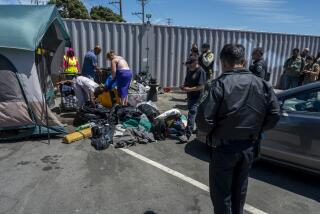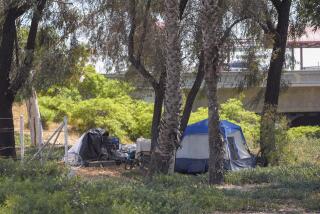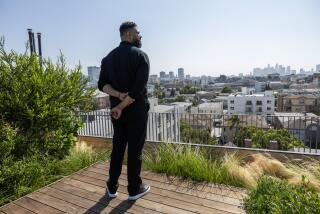A New Kind of Haven for the Homeless
- Share via
Most people thought Ted Hayes was dreaming when he proposed a homeless community where society’s rejects could get back on their feet.
Hayes is the voice of L.A.’s homeless. He joined their ranks several years ago as a self-appointed advocate. As the number of homeless people soared and public tolerance decreased, Hayes stuck with it, organizing street dwellers in a Skid Row encampment called Justiceville.
Justiceville broke up, the victim of opposition of merchants and of city officials who said it had become a haven for drug dealers and users. But the idea lived in Hayes’ mind. He persuaded some of the city’s rich and influential to back him, and got enough money to build a village of 18 fiberglass domes on an old parking lot in Downtown Los Angeles, just west of the Harbor Freeway.
*
The domes, 20 feet in diameter, are in an old parking lot in a downscale part of town where the most notable feature has been the big United Parcel Service facility on 9th Street. They were sparkling white in the dim, cloudy afternoon sunlight of a recent day, a marked contrast to the general dinginess of the rest of the neighborhood.
I exchanged greetings with Hayes, a tall, intense African-American man with a big voice and a friendly manner. He was dressed in spotless white from shirt to shoes, his outfit topped by a large straw hat.
It was the first time I’d seen him since this last mayor’s election, when he finished 12th in a 24-candidate field. His campaign had seemed quixotic but he had a purpose: to put the homeless on the political agenda of a city that wished they’d just go away.
He’d been planning the village during the campaign. Afterward, David Adams, a major Downtown area property owner, helped Hayes put the project together. A $250,000 gift from Arco, along with other donations, allowed them to lease the land for $2,500 a month and to pay for the domes.
Homeless people assemble the domes at the site and place them on circular concrete slabs. We inspected a couple that were awaiting interior walls and furnishings. A wall down the middle will divide each dome into two rooms, for homeless individuals or couples. Privacy is assured. “We’re allowing unmarried couples to share a situation, gay couples, “ Hayes said. “Each homeless person’s dome is his castle.”
Three domes are joined together for a kitchen and dining room. Toilets and showers are in two other domes.
Some might wonder if the homeless are capable of keeping the place up.
But Hayes and some academics who have studied the homeless say they can. What they’ve found is that many of the homeless have developed a sturdy self-reliance and strong organizational skills on the streets, living in encampments or their cars rather than waiting for handouts in a shelter.
This might not be evident to someone driving past an encampment under a freeway. But USC scholars Jennifer Wolch and Michael Dear took a closer look at the phenomenon in their book, “Malign Neglect.”
“These informal communities often became cooperative groups organized to provide security for members and their possessions,” they wrote. Friends could be found in the camp, messages picked up, information swapped. Labor was divided. Group decisions were made. People assumed authority.
Most important, encampment residents were independent. “Although street encampments lacked a roof and four walls, homeless women often felt they allowed a better and more stable life than residence in a hotel or shelter,” the authors wrote. “There was no rent to pay and no hotel or shelter rules (which often limit the duration of residence, impose curfews or restrict visitors).”
*
Hayes has long known this fact of homeless life. That is why all the residents of his domed village are being recruited from encampments.
“They are showing signs of life amid the most degrading circumstances,” he said.
The village is planned as just the first step in the comeback of the village’s residents. They will cook and clean. Phones will be available to connect with families, doctors, welfare workers and, in some cases, with jobs. Addicts will have 12-step programs. Medical help will be available for a population battling increased cases of AIDS and tuberculosis.
If this village works, there may be more, providing a way for the homeless to rejoin the rest of the world. Hayes persuaded Mayor Richard Riordan to give the idea a chance, and permits were rushed through city departments in an amazing three weeks.
Dedication day is Nov. 5. Then we’ll see if the dome village provides a way for the homeless to walk away from the misery of street life.
More to Read
Sign up for Essential California
The most important California stories and recommendations in your inbox every morning.
You may occasionally receive promotional content from the Los Angeles Times.










